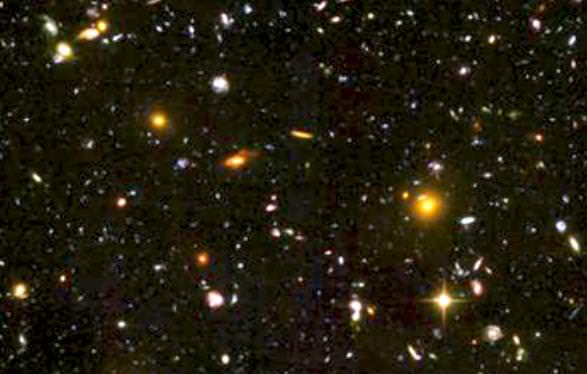[/caption]
It’s a well known fact that galaxies come in two types – either actively forming stars or not. In simplistic terms, that means they are either awake or asleep. But now scientists are looking back twelve billion light years across time to find the same holds just as true then as it does now. As a matter of fact, galaxies may have been behaving this way for around 85% of the history of the Universe.
“The fact that we see such young galaxies in the distant universe that have already shut off is remarkable,” said Kate Whitaker, a Yale University graduate student and lead author of the paper, which is published in the June 20 online edition of the Astrophysical Journal.
So, without poking the sleeping dragon, just how did the astronomers make their determinations? Try with the use of a 4-meter Kitt Peak telescope in Arizona and a special set of filters developed by Whitaker and her team. Just like all astronomy filters, this new breed is selective to certain bandpasses, or wavelengths, of light. These new filter sets were then used on 40,000 galaxies over a 75 night period and the data collected and examined. The end product was the deepest and most comprehensive of its kind so far. Active, awake galaxies appear more blue, while the sleepy-heads appear red. Believe it or not, when it comes to the cosmic bedroom there’s more activity than previously thought.
“We don’t see many galaxies in the in-between state,” said Pieter van Dokkum, a Yale astronomer and another author of the paper. “This discovery shows how quickly galaxies go from one state to the other, from actively forming stars to shutting off.”
Whether the dozing galaxies have completely shut down remains an open question, Whitaker said. However, the new study suggests the active galaxies are forming stars at rates about 50 times greater than their somnambulistic counterparts. “Next, we hope to determine whether galaxies go back and forth between waking and sleeping or whether they fall asleep and never wake up again,” van Dokkum said. “We’re also interested in how long it takes galaxies to fall asleep, and whether we can catch one in the act of dozing off.”
Pass the Red Bull… and sing the blues! “Are you sleeping? Can you hear me? Do you know if I am by your side? Does it matter? If you hear me? When the mornin’ comes I’ll be there by your side… There was a time, we had a time. There was a time we had time…”
Original Story Source: Yale Daily Bulletin.


Lots of evidence for a big bang but the further we look the more we see a steady-ish state. Either it must have all settled down very quickly or the truth is different from current mainstream theories. Bring on the James Webb and large array telescopes..
Not quite. If we discount inflation, which isn’t validated by itself (nearly, but not quite yet), the earliest observation we have is Big Bang nucleosynthesis. That characterized a transient (minutes long) initial state.
All according to standard cosmology.
Lets see. Our sun will burn out in about 4 billion years when it’s 8 billion years old. All stars bigger then our sun will burn out quicker. (the bigger the star the faster it burns). The only stars left after our sun burns up should only be the midget long burning suns. When we look at galaxies 12 billion years away, we are looking at them 12 billion years in the past. (four billion years before our sun was born). Since the universe was created 13 billion years ago and all galaxies were created at the same time how come our galaxie is 8 billion years younger then these old red shift galaxies. For that matter how can we live in an active blue shift galaxie that’s 13 billion years old? It would seem that galaxies were not all created at the same time – 13 billion long years ago.. So much for the big bang.
Tomestone
First, your math is off: for 85 % of the history of the Universe, 14 Gy goes with the 12 you mention. (The universe is ~ 13.7 Gy old.)
Second, the Milky Way is ~ 13 Gy old (oldest star is ~ 13.2 Gy old). Active star formation means some stars are younger, like our ~ 4.5 Gy old sun.
Removing these inconsistencies, we see that these figures are consistent with standard cosmology. But of course.
As all old and well tested theories, it is hard to reject it based on one observation. The above is an illustrative example, it is more likely that the observation is mistaken.
On the other hand, if it would fall, it is also hard to come up with alternate theories that explain all of the observations a well tested theory explains. (We certainly have nothing near as good an alternative any longer.) Then it is likely that a slight modification is what is needed.
So much for tearing down well tested theories.